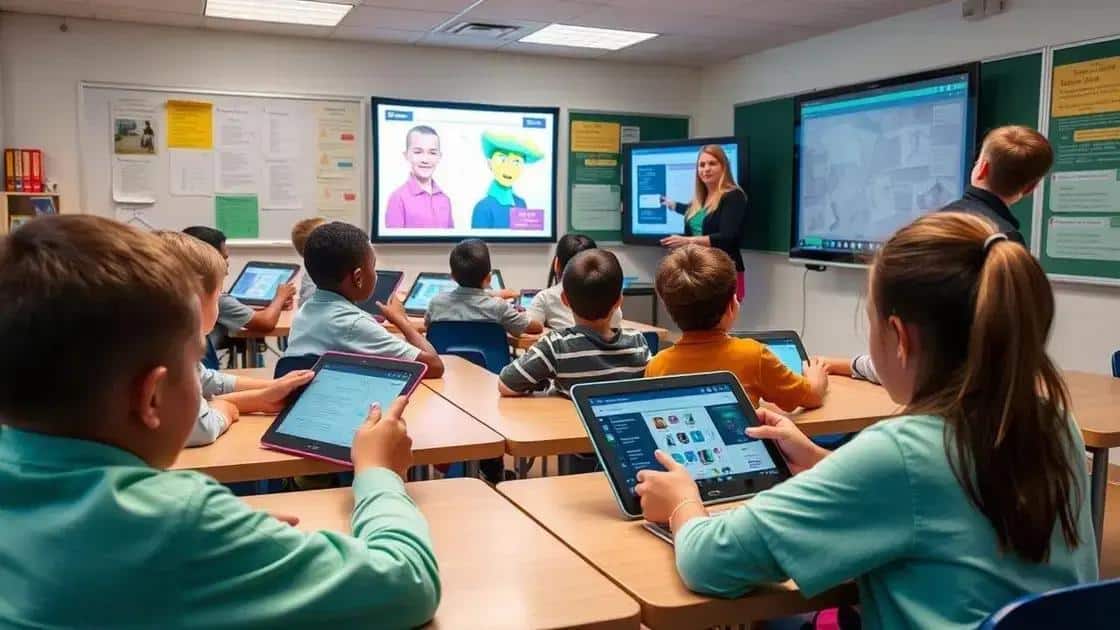Digital literacy curriculum trends shaping future education

Digital literacy curriculum trends focus on integrating technology, promoting critical thinking, and preparing students for a digital future by addressing challenges and embracing innovative teaching methods.
Digital literacy curriculum trends are transforming how we approach education in a technology-driven world. Have you noticed how vital these skills have become in our daily lives? Let’s dive into the latest trends that are reshaping learning.
Understanding digital literacy in education
Understanding digital literacy in education is crucial for students to succeed in today’s technology-rich world. It means more than just knowing how to use computers; it involves navigating information, using digital tools effectively, and understanding online safety.
What is digital literacy?
Digital literacy encompasses a range of skills required to thrive in a digital environment. It includes:
- Using devices such as computers, tablets, and smartphones
- Finding and evaluating information online
- Communicating effectively through digital platforms
- Understanding digital security and privacy
As technology evolves, so do the skills needed. Students must be prepared to engage with digital content critically. This involves questioning information sources and recognizing bias when exploring different viewpoints.
Importance of digital literacy
Digital literacy is essential because it empowers individuals. People with strong digital skills can:
- Access a broader range of resources
- Engage in scholarly discussions
- Collaborate on projects remotely
- Prepare for future career opportunities
The education system plays a vital role in fostering these skills. Schools need to integrate digital literacy into their curriculums to help students adapt to a rapidly changing world. This includes teaching them how to research online, use digital tools for learning, and engage positively in virtual communities.
By nurturing these essential skills, we can ensure that students are not only consumers of technology but also creators and contributors in the digital landscape. Ultimately, understanding digital literacy is about preparing students for life beyond school, equipping them with tools they will use throughout their education and careers.
Key trends in digital literacy curriculum

Key trends in digital literacy curriculum are shaping how students learn essential skills. As technology becomes more integrated into our daily lives, schools must adapt their teaching methods. Let’s explore some of the latest trends that are impacting digital literacy education.
Integration of technology in the classroom
One major trend is the increased integration of technology in the classroom. Educators are now using various digital tools to enhance learning. This includes:
- Interactive software that engages students
- Online resources for research and collaboration
- Virtual classrooms that extend learning beyond school hours
- Use of social media for educational purposes
By incorporating these technologies, teachers help students develop a more profound understanding of how to use them effectively.
Emphasis on critical thinking
Another important aspect is the emphasis on critical thinking skills. Students are encouraged to analyze information, evaluate sources, and make informed decisions. This skill set is vital in a world flooded with data and misinformation. Educators promote questioning and exploring different viewpoints to improve student’s judgment.
Additionally, incorporating real-world problems into lessons helps students apply their digital skills. By solving relevant issues, they gain practical experience and understand the importance of being digitally literate.
Furthermore, teachers are encouraged to provide personalized learning experiences to cater to different student needs. This approach uses adaptive technology and differentiated instruction to ensure all students achieve their potential.
In alignment with these trends, many schools are also focusing on teaching online safety. Understanding how to navigate digital spaces safely is essential for today’s learners. This includes recognizing scams, understanding privacy settings, and using secure passwords.
As these trends evolve, the importance of a robust digital literacy curriculum becomes increasingly clear. By staying informed and adapting to changes, educators can prepare students for success in a digital world.
Challenges in implementing digital literacy programs
Challenges in implementing digital literacy programs can impact the effectiveness of education significantly. Although integrating these programs into schools is essential, various obstacles often arise that can hinder progress. Addressing these challenges is key to ensuring that students receive the skills they need.
Limited resources
One significant challenge is the lack of resources. Many schools face budget constraints that limit their ability to purchase necessary technology and software. This can lead to:
- An insufficient number of devices for students
- Outdated software that does not meet current standards
- A lack of professional development for teachers
- Limited access to high-speed internet
When schools do not have the right resources, it becomes difficult to create a comprehensive digital literacy program. Students may miss out on vital learning experiences.
Resistance to change
Another challenge is the resistance to change among educators and administration. Some teachers may feel uncomfortable using new technology or integrating it into their lessons. This resistance can stem from:
- A lack of training or confidence in using digital tools
- Fear of failing to meet educational standards
- Concerns over the effectiveness of digital resources
Overcoming this resistance requires ongoing support and collaboration among teachers. Creating a culture of continuous learning can foster a more adaptable approach to digital literacy.
Consistency in curriculum implementation also poses a challenge. Ensuring that all teachers apply the same standards and resources can be difficult. Some may prioritize traditional methods over digital ones, leading to uneven learning experiences among students. To tackle this issue, schools need clear guidelines and expectations for digital literacy curricula.
Finally, addressing the digital divide is crucial. Not all students have the same access to technology outside the classroom. Differences in socioeconomic status can create disparities in digital literacy development. Schools should consider providing resources for students who may not have access to the internet or devices at home, ensuring equitable opportunities for all learners.
Future predictions for digital literacy education

Future predictions for digital literacy education suggest that we will see significant changes in how learning is approached. As technology continues to advance, educators are adapting their methods to prepare students for an increasingly digital world. It is crucial to explore these trends to understand what lies ahead.
Increased use of artificial intelligence
One major trend is the increased use of artificial intelligence (AI) in education. AI can personalize learning experiences, helping students progress at their own pace. This can lead to:
- Tailored educational content based on individual needs
- Real-time feedback for students to improve skills
- Smart tutoring systems that assist learners outside of the classroom
- Automation of administrative tasks for teachers
By incorporating AI, schools can enhance digital literacy programs significantly, ensuring that every student receives the support they need.
Focus on coding and programming
Another prediction is a growing emphasis on coding and programming. In the future, learning to code will likely become a fundamental skill taught in schools. This development can prepare students for the workforce and help them understand the technology that drives our world. Important aspects include:
- Integrating coding into the general curriculum
- Offering extracurricular activities focused on programming
- Developing problem-solving skills through real-life coding projects
By learning these skills early, students will be better equipped for future careers in technology.
Moreover, the importance of digital citizenship will be highlighted in educational settings. As online engagement grows, teaching students how to navigate digital spaces safely will become critical. This includes understanding online ethics, privacy, and responsible communication. Schools must actively address these topics to prepare students for digital life.
Collaboration across borders is also likely to grow. Schools may increasingly partner with international institutions to share resources and knowledge. This global perspective can enhance cultural understanding and broaden students’ horizons. Collaborative projects can foster teamwork and improve digital skills through interaction with peers worldwide.
As these predictions unfold, the landscape of digital literacy education will evolve. Staying current with these trends will help educators create more effective and relevant learning experiences for future generations.
FAQ – Frequently Asked Questions about Digital Literacy Education
What is digital literacy education?
Digital literacy education refers to the teaching of skills needed to effectively use technology, navigate the internet, and critically evaluate digital information.
Why is digital literacy important for students?
Digital literacy is essential as it prepares students for the technology-driven world, enabling them to communicate, collaborate, and problem-solve in various contexts.
What are some challenges in implementing digital literacy programs?
Challenges include limited resources, resistance to change from educators, and ensuring equitable access to technology for all students.
What roles will AI play in future digital literacy education?
AI is expected to personalize learning experiences, provide real-time feedback, and assist educators by automating administrative tasks.





